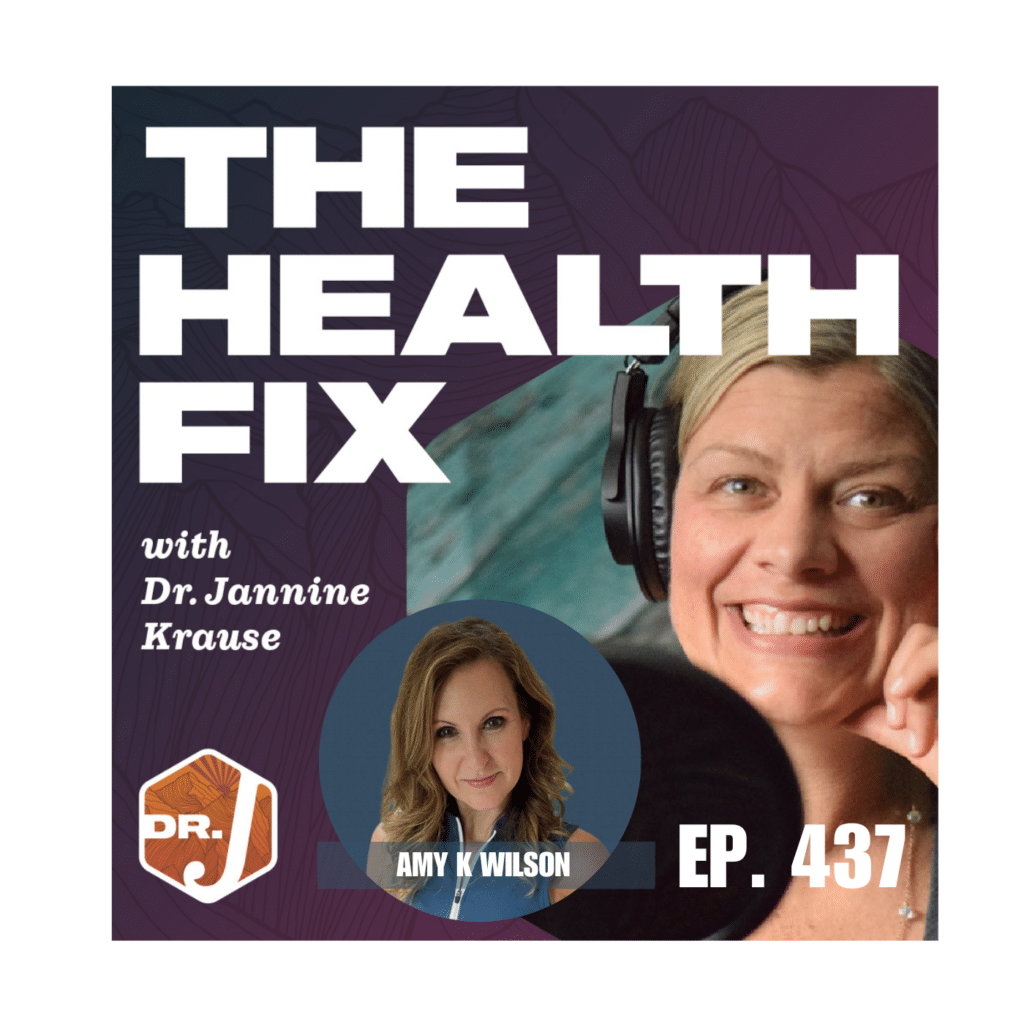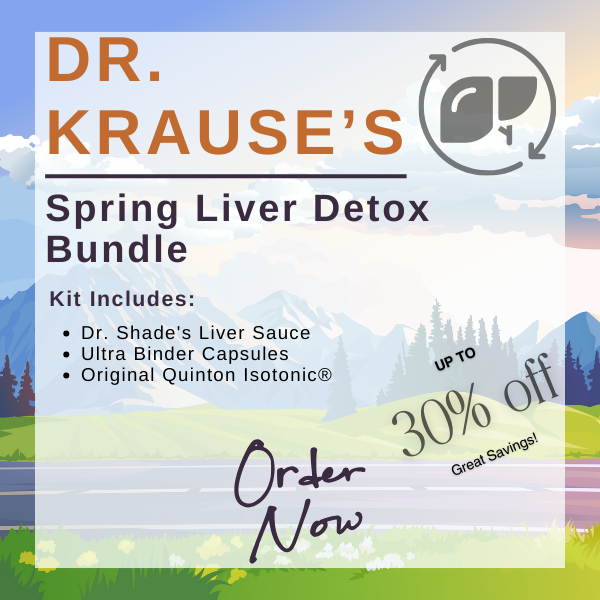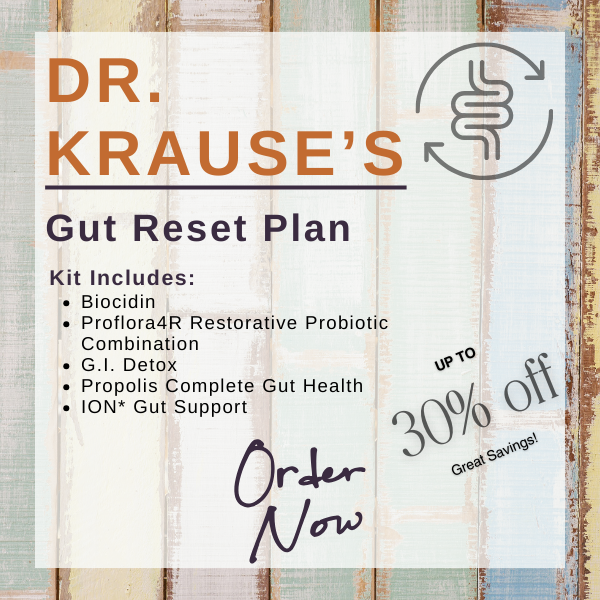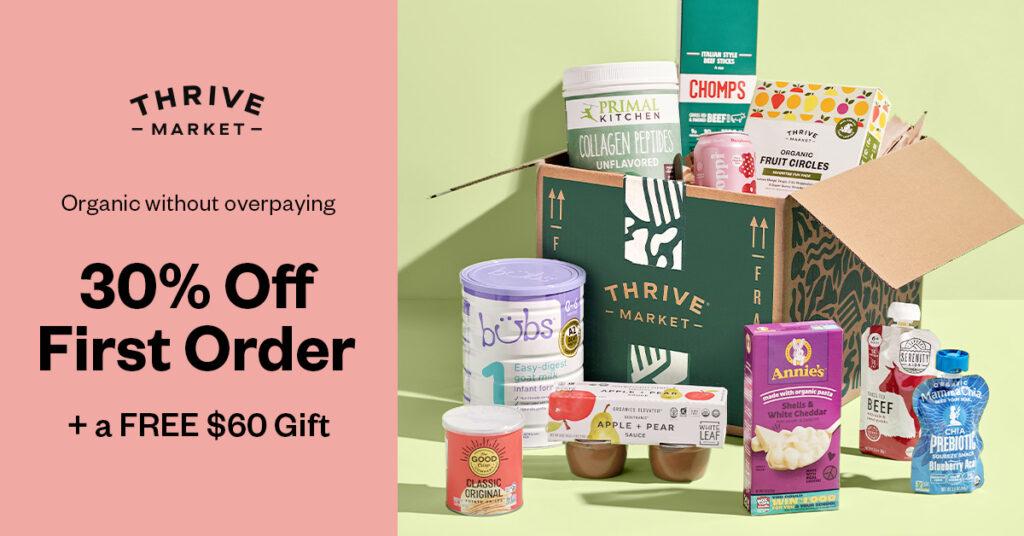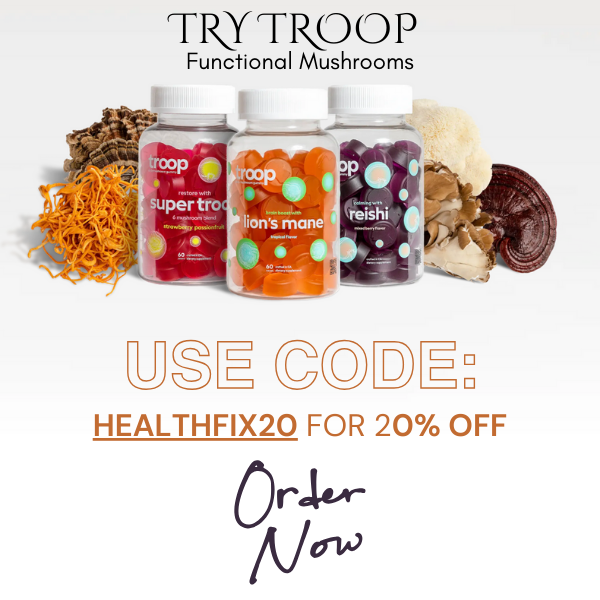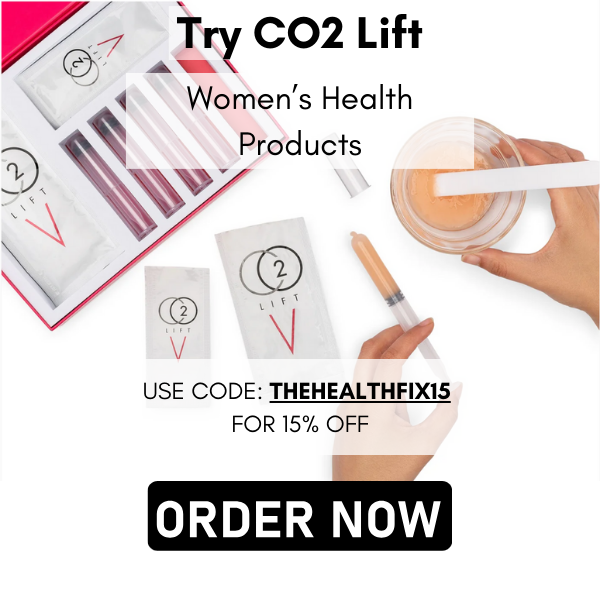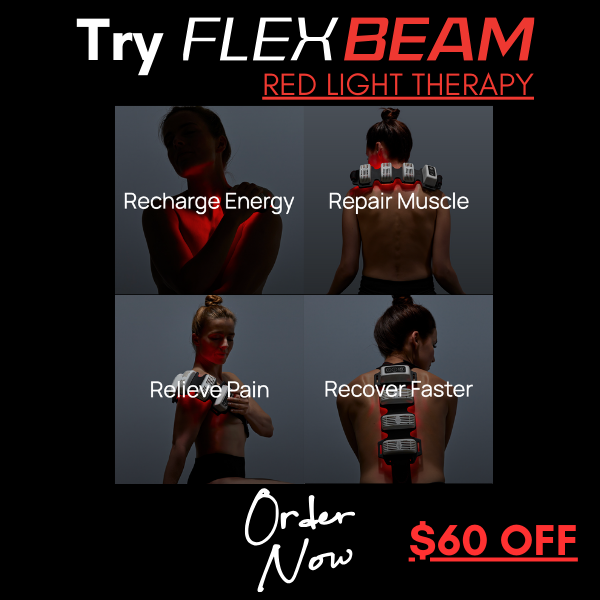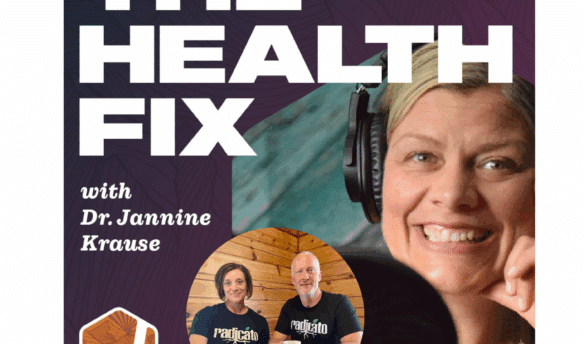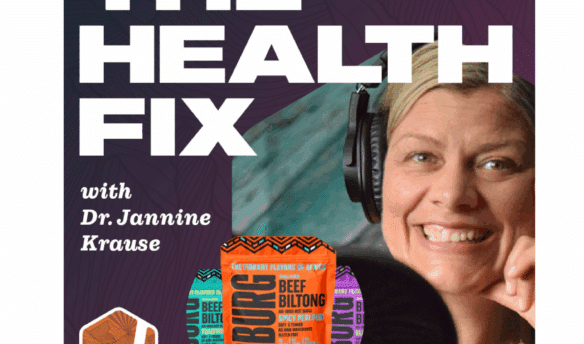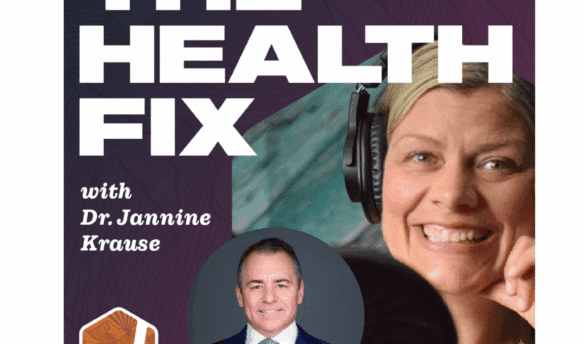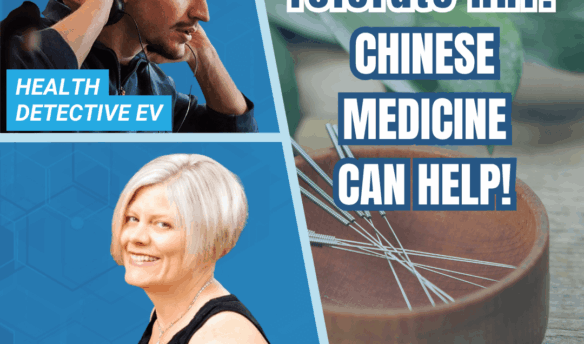Trying to lose weight but nothing seems to be working? Been on every diet you can think of? Wondering what’s broken with your metabolism? Thinking of trying semaglutide or Ozempic? Amy K Wilson is a Board Certified Geriatric Pharmacist, a certified fitness professional, and a certified nutrition coach using the FASTer Way to Fat Loss platform, who is working to disrupt the diet industry by helping her clients take their life back. After reviewing charts of nursing home residents younger than her that revealed life choices as the compounding factor that landed them in the nursing home, Amy went on a mission to help women understand their metabolisms. In this episode of The Health Fix Podcast, Dr. Jannine Krause interviews Amy K Wilson on the risks of prolonged caloric restriction, overexercising, fad diets and semaglutide.
Dr. Krause’s Protocols
Instructions Included
Traveling soon? Looking to detox or reset your gut? Try one of Dr. Krause’s Fullscript plans.
What You’ll Learn In This Episode:
- Why you’re losing muscle & gaining fat despite diet and exercise
- How preventable life diseases are landing folks in nursing homes
- Why “Ozempic butt and face” happen
- Reasons for a1c and cholesterol to go up with age
- Why your body is one big chemical reaction
Resources From The Show:
- www.amykwilson.com
- IG: Thenutritioncoachpharmacist – send her a DM “healthfix” – free 5 day fat loss blueprint
Our Partners
Podcast Transcript
2:30 – Amy’s story
9:40 – Side effects of pharmaceutical drugs
11:24 – Why you shouldn’t focus on weight loss
18:00 – How the 80’s diet fads have set us up for where we are in 2024
23:34 – Eating less food doesn’t always equal weight loss
27:35 – Tips to get more protein in the body
30:17 – Hot chocolate protein
31:46 – Fasting
39:52 – Mindset
43:40 – Working out for life’s tasks / functional fitness
47:48 – How to find Amy
JANNINE: [Intro] Welcome to the Health Fix Podcast, where health junkies get their weekly
fix of tips, tools and techniques to have limitless energy, sharp minds and fit
physiques for life.
Hey health junkies on this episode of the Health Fix Podcast, I’m Interviewing Amy Wilson.
She’s a board certified geriatric pharmacist, a certified fitness professional,
and a certified nutrition coach using the faster way to fat loss platform.
form. Amy is fabulous. She cracks me up. We have very similar
thoughts when it comes to health care and helping with
preventative medicine. But the best part about Amy, she’s a
pharmacist that works in a clinical situation. What does
that mean? She reviews charts all day long. What does that
entail? You’re looking at data on people from basically the
course of their history. And because she’s a geriatric
pharmacist, she is in a nursing home. She’s seeing folks
younger than ever coming into nursing homes. She’s seeing
why they’re coming in huge insights into how not to end
up in a nursing home. So that is the theme of this
podcast, but also just lots of other information on
semaglutide and other things and what she’s seeing out
there as side effects of not taking care of yourself
as you get older.
So I’m excited for this podcast.
I hope you are too.
Let’s introduce you to Amy K. Wilson.
– Hey, health junkies.
I have Amy Wilson on and I’m excited today
because I get to geek out quite a bit here.
And so Amy, welcome to the health fix podcast.
AMY: Hey, thanks for having me.
I am excited to geek out with you today
’cause that’s my favorite thing to do too.
JANNINE: I’m a nerd at heart and knowing that I’ve got somebody on
that’s a pharmacist, always brings joy to my heart
because I can pick your brain on all kinds of things.
And in particular today, we’re definitely gonna take it
in a different direction than folks might be thinking
about all pharmacy.
We’re gonna talk about what happens when you do get
these certain meds in the body.
And in particular, we’re gonna talk about the Ozempic
and summit glutides here in a second.
Hut, gourd certified geriatric pharmacist.
JANNINE: What got you towards that direction?
Like what was the impetus for that?
AMY: To be honest, I hate retail.
(laughing)
JANNINE: Yeah.
AMY: No, no, I did the retail center.
When I first started out in pharmacy years ago,
I’m in my fifties, I went the retail route
and then did a little bit of long-term care
during that time, moved to Chicago.
And guess what’s on every corner in Chicago
was Walgreens, right?
So I worked at Walgreens.
I worked at one of the busiest Walgreens
back in the day on Michigan and Chicago.
It was great.
I absolutely loved it.
And then life took me to Louisville, Kentucky
and just wasn’t feeling the Walgreens love as much
or the retail love as much.
And I’m like, you know what?
I need to get back to my clinical roots.
I really want to do something that I feel is more impactful
and went back to long-term care.
And with that, I’m a nerd, I’m the same way.
And it’s the same thing when I got my fitness certifications,
I’m certified in pretty much everything except yoga.
And then with my nutrition certifications,
I just keep getting more and more and more
because I am a nerd and more information.
So like, well, you know what, I’m in the geriatric realm.
There are several different board certifications
with pharmacy now.
There’s oncology, there’s PEDS,
there is medication therapy management
and they have one for geriatrics.
And being a consultant,
dealing with the geriatric population,
although some of my people in my nursing home
are not geriatric population, which we can talk about,
I wanted to have more something.
I wanna sink my teeth into it, get really into it.
And so therefore I studied
and became board certified geriatric pharmacist.
So I am a long-term care consultant.
I go into nursing homes, CMS regulations
is that every chart gets reviewed by a consultant
or a pharmacist every single month.
And that’s what I do.
JANNINE: Wow, wow.
Ooh, that’s a hefty job.
Now, exciting though too,
because I bet you can see some really good things happen
based on different meds,
but also you’re seeing side effects,
which is where, of course, I wanted to go
with a lot of these things.
And in particular, looking at what’s going on
with this explosion of semi-glutide and Ozempic.
And I’m guessing that you’re seeing some folks,
even in the long-term care facilities
that are using these products.
‘Cause you mentioned younger folks,
not geriatric in a long-term care facility,
give us a skip, what are you seeing?
AMY: So what I’m seeing is,
and this is where kind of everything just comes together.
I say I’m a triple quantity, I have fitness,
I have nutrition, I’m a pharmacist.
What I’m seeing is preventable life diseases
that are coming into the nursing homes,
40 year olds, 50 year olds, early 60s.
And it’s heart disease, diabetes, strokes,
it’s lifestyle.
it is things that could definitely be prevented.
There are, it’s hard because I’ll do a mission review
and I’ll see someone has my date of birth or younger.
And so me, me, I’m digging into the history
and physical, the H&P and looking at everything.
And you can see the cascade effect of poor health choices.
You can see what happens.
And that’s not to say, some people definitely,
There are issues, there are disease states
that we can’t prevent, but there’s a lot of things
that we can do.
And when I’m seeing younger and younger residents coming in,
that’s not a lifestyle that I don’t think anybody
even thinks about.
They don’t think about being 50 and being in a nursing home
or 40 and being in a nursing home.
We think in the now, we don’t think in the future.
And as I was going through my nutrition,
kind of what I was going through with me
with perimenopause and menopause
and getting my act together and realizing that,
Hey, am I A1C is going up, which is for those who don’t know,
it’s a prediabetes marker, my cholesterol is going up,
everything’s going up.
And here I am, a nutrition coach and I teach classes.
What am I doing wrong?
What’s going on?
And realizing that there’s so much misinformation out there that when you go
back to the science and realize with the science that what that tells you is that,
Hey, we have all this stuff right at our fingertips.
We just choose not to listen.
We want sometimes for us, we want something that’s almost the easy button, but something we don’t
have to think about. The problem with the GOP ones in my nursing homes are the one thing that the
GOP ones will tell you if this works with in conjunction with diet and exercise. Every single
thing that you see with the GOP ones says you must have this in conjunction with diet and exercise.
Well, in my facilities, guess what, they’re not getting diet and exercise, so I’m not seeing the
great results with GOP ones in my facilities. They’re on them. It’s as an adjunct to other
medications because they are full-blown type two insulin-dependent diabetics.
Is it helping them with losing weight? No. Is it helping them with insulin sensitivity?
not judging by the A1Cs.
I would say 80% are not seeing the good results.
20% seeing some decent results with them,
but it’s not the miracle drug that,
when we talked about this just before we got on the call
about going across the board
and thinking something is good for everybody,
not everything works for everybody.
And what people have to understand is that
it may not work, but it’s still gonna carry the side effects.
And that’s something that you have to think about,
that any medication, and even supplements,
people get, I’m gonna take this supplement,
or this diet supplement,
and think that there’s not a possible negative outcome.
There is always a side effect.
You just have to understand that there’s always a side effect,
to be prepared for the side effect,
and understand that that side effect,
you may think it may not happen to you,
but there is always that good, good possibility
that you might be one of those people,
one in 10 who it happens to.
JANNINE: Yeah. No, it’s definitely one of those things. And yes, before
we hit record, I had said that a lot of people are contacting me and saying, “Hey, Doc, I want to
lose some weight. I want to use Semaglutide.” And now, of course, we can’t get it from compounding
pharmacies. We have to look at sources that are basically for research purposes only to be able to
get a hold of it. And, you know, I really wanted to speak to who, you know, these folks who are
asking for this for a magic basically of, oh, I just need to drop 20 pounds. Have you ever seen
that happen with anyone that you’ve worked with and give us like the actual impact of what that
could cause for someone?
AMY: Okay. So let’s dive in. First of all, let’s really dive in on what
what happens, let’s hope scar side effects.
So can you lose 20 pounds?
Yes.
Okay, before you go, yes, sign me up.
I need this now.
Let’s talk about the negative outcomes.
And that’s what we don’t realize.
We think that, oh my gosh,
there’s finally something for weight loss.
Sign me up, I’m gonna take this.
I don’t care what happens.
Okay, well, with GLP once,
What happens is it slows down your digestion,
so you’re not hungry.
Okay, sign me up.
Got it, that’s my problem right there.
But it slows it down so much that you’re nauseated.
You may be constipated.
You may get some people might actually have some diarrhea issues.
It may slow it down to the point
of causing something called gastroparesis,
which is the total shutdown of your GI system.
The problem with that is it’s not reversible.
And if anybody knows anybody who has gastroparesis,
it’s not pretty.
JANNINE: No.
AMY: And you don’t want to be in your 40s, 50s
and be dealing with that for the rest of your life
because that is now gonna be your focus of attention.
It’s not worth those 20 pounds to get that.
The other problem is with not eating,
you are not getting in nutrition.
I am a nutrition coach who does not focus
so much on weight loss.
And I know people are like,
well, I’m not working with her, I want to lose weight.
Well, let me tell you why I don’t focus on weight loss
because weight loss and weight,
the scale means absolutely nothing.
When you step on the scale and you lose a bunch of weight
and when I tell you it’s not fat,
it’s probably more than likely a little bit of fat
and mostly muscle.
You slowed your metabolism down.
That’s why every time you went on a diet
and you lost weight very, very quickly,
it came right back on and it brought friends.
It does.
And then you’d be like, okay,
why would I try this diet again?
Well, why didn’t it work this time?
Because girlfriend, you didn’t have muscle to lose.
Your body’s like, oh, hold on for a second.
No, no, no, no, no, you’re not taking my muscle.
You’re not.
And then your body counteracts with adding more fat.
“Well, crap, that’s not what I wanted.”
So when you have something like Semaglutide
that stops your, what you’re eating,
you’re gonna lose muscle.
Why are people getting a Ozempic face in an ozempic butt?
It’s not the fat that they lost from those areas.
It’s the muscle they lost.
Muscle’s what gives you shape.
So when they have this now flat butt,
it’s because they lost all that muscle in their tushy.
And there’s no shape to it.
same thing with your face or the face gets like sunken in,
there’s muscle in our face.
So you lose muscle, you’re also losing your metabolism.
Now, you’re not bringing in food.
So you’re not building muscle.
You’re not bringing in amino acids.
So your body needs amino acids going to take it from muscle.
You’re not bringing in vitamins and minerals.
Guess where it’s going to go?
Your body’s smart, it’s going to survive.
It’s going to start taking it from the bones.
So what I am really worried about is starting to see
35, 40, 45 year olds who now have osteopenia,
osteoporosis, sarcopenia, and I’m afraid
we’re gonna start seeing hip fractures
that we normally see in 80 year olds,
we’re gonna start seeing those in 40 year olds.
And the problem is, is that not only is,
are you losing weight on it, which everybody’s like yes,
but you’re also getting a psychological dependence on this.
Because we know that you stop the injections,
the weight can come back.
JANNINE: Yeah.
AMY: And I was talking to someone a couple of weeks ago
and she said she had a client who came to her
because she wanted to get off of it,
but didn’t want to get off of it.
And I’m like, what do you mean?
She’s like, well, she’s on the couch.
She can’t move.
She’s exhausted all the time.
she lost the weight that she wanted,
but she’s afraid to go off the medication
because she’s gonna gain it all back, but she’s not living.
So you can be skinny and be very unhealthy.
And if you can’t live, what’s the purpose?
There’s a huge disconnect that we think
that skinny equals healthy, it’s not.
What we need to start figuring out is
How can I heal within?
How can I be healthy and especially in midlife?
How can I start keeping my muscle and adding my muscle?
Quit worrying about skinny.
I know all of us, allow us to grow up in the 80s,
skinny was the thing, flat butts was the thing.
We wanted to be in these skinny jeans.
That wasn’t healthy.
Was it healthy then?
It’s not healthy now.
And especially as we are in midlife,
it’s definitely not healthy
because what that lifestyle will do
is give you a one-way ticket to the nursing home.
And I don’t think we want that.
I think all of us want to be on the beach
enjoying life and living life to the fullest
no matter what age we are,
that we don’t want to be just sitting in a nursing home board.
(laughing)
I mean, it’s not living.
It’s not.
So I think that we have to realize
that even though the news shows
but this is an a miracle, it’s a miracle.
And I’m not someone against medication.
If somebody wants to be on it, there’s a way to be on it
and to make sure that you are eating,
to make sure that you’re keeping your muscle mass
and making sure there’s a, I won’t say a escape plan,
but a plan to get off and understanding
that we’re doing for your health, not to get skinny.
I would prefer to do the other route
because a lot of people will say, well,
I’ve tried everything, I’ve tried everything.
I’m gonna say, you’ve tried every fad diet out there
and they don’t work.
Have you tried health?
Have you tried healing within?
Have you tried actually eating real food,
not the ultra-processed food,
working on decreasing your chronic inflammation
and working on increasing your muscle mass?
I can say probably most people will probably say,
well, no, not really, not really.
I thought I was eating healthy, I googled it.
I thought I was eating what I was supposed to,
but it just didn’t work.
Well, because you weren’t doing the right things
for your body, you thought you were doing the right things.
And let me tell you, everybody, I understand.
We think we’re doing the right things.
We Google it, we read about it,
and we’re told so many things,
it’s almost analysis paralysis
that we think we’re doing everything right.
Sometimes you need a little help.
Sometimes you need some direction to get you there
understand it is a slow freaking process and embrace the journey and realize that your start date is
when you ever start to start and you don’t have an end date. It’s not a 10-day fix, a 21-day fix.
It’s not a six-week. It is a lifestyle that you will have to change behaviors and habits,
but you’ll be better for it than relying on a medication that can give you a lot of side effects.
JANNINE: Absolutely. Absolutely. And I think this is something that we need to just keep repeating
over and over again, and maybe it’ll set in, maybe not, you know, as human nature is where we’re
looking for that quick fix. But one thing that I do think really does get the attention of a lot
of women that I see is when they’re seeing, like you had mentioned, your A1C is going up,
your cholesterol is going up, and you’re like, okay, I’m starving myself. I am working out, you know,
I’m not able to keep these things in check. What do I do? And so usually in my world,
the first question is, you know, are hormones going to fix it? Well, I’m like, yeah, sure,
they can help a little bit. But I definitely want to hear from your side of things. What,
what are you doing to help with, with these factors that folks start to see happening as we get older?
So hello, my name is Amy K. Wilson. I was a cardio junkie. And I, and, and what’s funny is,
is that I have a lot of different certifications in nutrition. And a lot of them did not put
together science, which we’ve come a long way with nutrition. Back in the 80s, it was all low
fat. You know, we have, oh my gosh, we have to get rid of the fat. So what we do, we have fat-free
this, low fat this, we’ve added all our sugar. Okay, hello diabetes, we put, we have set ourselves
up for where we are here in 2024. We have with our lifestyle changes, with our dietary changes,
with ultra-processed foods, we have created the ozempik wagobi pandemic. We have.
And I’m sure big pharma is like cha ching, thank you so much. But what we’ve been doing is wrong,
and what I was doing was wrong. Thinking that I had to spend hours doing cardio,
thinking that I need to start cutting more and more food, no carbs, you know, higher fat.
doing all, you know, the keto, the keto craze. What was happening was, let’s go
back to science. I’m not fueling my body and I’m working out all the time. I was
teaching 15 classes plus doing my own workout because I will kept getting bigger
and bigger and I’m trying to figure out what the heck’s going on. Well, I’m not
getting my body what it needs. Our body is one humongo big chemical reaction. The
The food and minerals and vitamins that we give it can either help those chemical reactions
or it can hinder those chemical reactions.
Our bodies program to try to survive no matter what.
To give it the optimal, we have to give it real food, get rid of ultra processed foods,
the junk food, the candies, the sugar, alcohol, yes, you can drink alcohol every once in
a while and yes, you can have a cookie every once in a while but I’m talking about every
single day.
And we have to start fueling our body to take care of it, not under eat, which most women
under eat, or we’re overfed under nourished.
And what I mean by that is, I’m going to throw some people under the bus, Lean Cuisine
Healthy Choice, any diet, shake, all those kinds of things that we might have a lot of
chemicals, ultra processed foods.
We’re eating a lot of those.
Can’t understand that we’re eating all this diet food
and then nothing’s working.
Well, once again, you’re not giving your body
the right chemicals in order to have the reactions.
So your body’s gonna hold on to fat.
Your hormones are gonna be in disarray.
Your gut microbiome is gonna be nonexistent
because you’re not giving things to feed the gut microbiome.
You’re giving things to actually kill your gut microbiome.
Splenda, Equal.
A lot of artificial sweeteners.
So when we can dial back, look at the science and say,
hey, you know what, I need protein.
I need carbohydrates, I need fat,
and not only do I need that, I need quite a bit.
Not this 1,000 calories a day thing,
and quit thinking about calories,
start thinking about in terms of macronutrients,
your fat, your protein, your carbohydrates,
I need those things.
And the other thing that I need is, I do need cardio,
but I don’t need excess.
Because when I’m doing excess and I’m not fueling my body,
well then my body’s gonna take that energy
for someplace else.
It’s gonna take it from my muscle, not the fat.
I know everybody’s like, oh, but I was told
that if I don’t eat, I work out in a fasted state
and everything else that I’m gonna burn body fat.
No, unfortunately not unless you’re fueling your body.
Everything has to be optimal.
And so if we can start fueling our body,
If we can start doing cardio for cardiovascular health,
not every single day, not hit training,
high intensity interval training
that leave it all on the floor every single day,
couple days a week, and then also we need
to add weight training so that we’re building that muscle.
It is miraculous of what can happen.
And it takes some time, it’s a learning curve.
It really is a learning curve
to understand how your body reacts,
how much you need and to be able to move forward.
It’s not like you said, we want everything now.
It’s not tomorrow, it’s like, oh, I started this
and tomorrow I should be in my next dress size.
No, no, no, no.
It takes a while.
It takes a while for your body to trust you again.
It takes a while for you start building muscle.
It takes a while for you to burn fat.
What I will tell you with most of my clients,
what happens in the first two weeks,
they do lose inches, but a majority of that is inflammation,
is that they are losing the inflammation
and then we’re given the optimal environment
for our body to start burning fat and building muscle.
JANNINE: Makes sense, makes sense.
And I think most of the quick weight loss,
we have to remind folks that that’s inflammation.
Wait, you take out chips, you take out process stuff,
you’re gonna drop some fluid.
That’s just how it’s gonna go.
But I definitely, and I’m sure you see this too,
in a lot of women, I will get that like, I’m not increasing the amount of food I’m gonna eat
because it’s gonna make me gain weight. There’s so much fear out there. Isn’t it remarkable?
AMY: Yeah, I was in the same way. I was the same way. And I watch the program I coached now,
I watched a couple friends do it, and they were looking amazing. And I’m like, okay,
they’re looking amazing, but they’re not only looking amazing, they’re feeling amazing,
and their muscle tone was just crazy. I was like, they’re not ripped. They’re not big.
but you could see a little indentation on their shoulders and they looked taller and they held
themselves themselves a little more, a little more confident. So I’m like, wow, that’s, you know,
I wasn’t feeling that and I wanted that feeling. And I was like, okay, well, maybe I need to do
this. And it was a program called Fast Way To Fat Loss and that’s why I coach now. And it was
hard, hard, and I kept telling myself,
okay, if what I’m doing now was working,
I wouldn’t be here.
I wouldn’t be trying to do something else.
And I told my coach that time I’m gonna be your worst client
ever, I’m gonna question everything.
‘Cause here I am, a pharmacist.
I have all these other nutrition certifications.
I’m just gonna be work,
’cause I’m a question everything.
And I said, but one thing I am gonna do
is I’m gonna jump all in.
I’m just gonna do it.
And I hear, I thought it was in our six week program.
I really did.
I thought, oh, no, six weeks will get me on my way.
I know everything.
Peace out.
And the amount of food I had to eat was crazy.
And now I can’t think of it.
I now I can’t think about not going without it because now I know how I feel and what
it does for me.
But at that time when eating 1,000, 1,200 calories and even though I knew about macronutrients,
I was still kind of on the calorie kick, it was unreal because the amount of food that
What you have to eat when it’s real food is totally different than when it’s processed
food.
If you look at a lean cuisine or something like that that’s like 250 calories, it seems
like it’s just this little thing.
And then if you actually are making your food, the broccoli, the salad, the chicken breast,
or steak, or whatever you’re eating or fish, it’s quite a bit more than, plus you need
more than 250 calories.
I’m going to tell you that right now.
And it’s crazy.
And I know a lot of women are like, especially my clients are like, wait a minute, wait a minute, but I’m gonna gain
Wait, and I’m like, so how’s that starvation working for you right now? Oh, it’s not it’s not you’re gaining weight right now
I can’t figure it out. So why don’t we try to do the opposite because obviously what we’ve been told is wrong and
When we start fueling our body and they are like wait a minute
I’m eating all this food and I’m dropping inches like crazy. What’s going on?
And I’m like congratulations your body’s finally saying I can work I can do the things I need to do
And it’s mind-blowing, but it’s scary, it’s so scary because we are programmed to move more, eat less.
That’s all we’ve been told.
JANNINE: Yep.
Yep.
Yep.
AMY: And it’s not true.
It’s not true, calories in versus calories out.
There’s differences.
And unfortunately, we take it to that simplistic level that that’s what we follow and it stops working and we can’t understand.
we can’t understand, so what do we do?
We drop more calories and we add more movement
and it still stops working, especially in midlife,
when we need fuel, when we need muscle,
and everything just starts to backfire.
JANNINE: It’s crazy how much backfiring happens.
And even like in myself, I’m now 45,
I’ve started to see, you know, I’ve got,
I’ve started to develop a little bit of a layer
of fat over my muscle, I’m like,
Holy cow, how did this happen?
Like, I’m, you know, I’ve been eating, you know, the same.
I do pretty, pretty good.
I’m like, what am I screwing up on, right?
And I’m like, wow, okay, I need more protein, right?
And once, once you get back on that,
you start going back to it, you’re like, it is so crazy.
And of course it is one of the biggest objections
that I get from my clients is like,
I don’t know how to eat that much protein.
I can’t do it.
What’s some of the advice that you give to folks
when you’re looking at like, how do I get in more protein?
What are, what are some of your tips for folks?
Because it does seem to be–
AMY: Bone broth.
JANNINE: Okay.
AMY: Bone broth.
And the reason I say bone broth is,
sometimes you just can’t eat another turkey breast
and their chicken breast.
You’re like, if I see one of these,
I’m going to just eat it now.
And especially like here, it’s raining,
it’s cold, it’s January.
Bone broth is a great way to increase your protein intake
with not feeling like you’re choppin’ down on something.
I also tell people, it’s like, okay,
it’s cold, maybe you don’t want to do a protein shake.
And also let’s look at your protein shake ingredients
because there are some nasty protein shakes out there
that are not doing you any favors.
But one of my favorite things is protein hot chocolate.
So it’s another thing that I can get protein in.
And then let’s look at what you’re consuming.
‘Cause if you only think it’s a chicken breast,
well, no, there’s a lot more than just chicken breasts.
There’s a lot more that we can do.
We can do egg whites, we can do eggs, we can do shrimp,
we can do tuna, we can do fish, we can do turkey.
We can have red meat a couple times a week.
So there’s all these other options that you have.
It’s just that sometimes we’re creatures I have,
but we just get in a rut.
And then there’s a lot of other things out there.
And it’s, I’m actually just trying this product out right now.
So I’m not affiliated with anything,
but it’s something called just meats.
And if you’re on Facebook, you’re gonna see it all the time.
But it is, they just send you pre-cooked organic meat.
organic meat. It’s been pretty dang good and it’s all different flavors and the sodium
content is good and the marinades are just spices. I’m pretty impressed because they
have chicken, they have beef and pork and you can chose and that kind of just keeps everything
kind of fresh so we’re not eating the same thing at all. So there’s things out there
to help you, don’t be afraid to get coaching. Don’t be afraid to get help so that you’re
not just Dr. Googling it and trying to figure out on your own because there is a lot of
misinformation out there. There’s a lot of crazy stuff out there and be okay investing
with yourself because investing in yourself because that’s going to help and it’s going
to also save you a lot of time, a lot of time. But I would say if the easiest, easiest one
that you could do today would be go to your store and get bone broth, not chicken broth.
the difference, get bone broth.
JANNINE: Nice, nice, yes.
On a cold winter day, having a little bit to sip on,
or even making a soup out of it can make it just glorious.
And the hot chocolate you mentioned,
now, how, give us your recipe.
What are you doing with that, isn’t it?
AMY: I have a chocolate protein mix.
I use a couple of different ones.
I use their, what’s called our fascia whey protein mix,
or equip prime chocolate protein mix.
I warm up either some coconut milk or almond milk
’cause I’m dairy free and just put it in my Vitamix blend it
and I have protein.
You can also do that with vanilla and coffee
or chocolate and make a mocha.
That’s another easy way to get some protein
that you’re like, I’m gonna drink it anyway.
And sometimes you know you want that Starbucks break
but you know, one, it’s expensive too.
It’s not good for you.
So you can make your own latte at home or at work
and it’s so good.
My one tip is use a blender though.
Don’t try to mix it.
Blending is what makes,
and it gives you that little froth on the top.
It’s perfect.
JANNINE: Ooh, yes, the froth.
That’s, there’s something about that.
I’ve been known to go after that for sure.
So tell us a little bit more about The Faster Way
To Fat Loss and how that looks,
because I think a lot of people,
if they see it, it says fast, so we’re thinking quick,
but a lot of people are gonna have so think fasting.
JANNINE: So.
AMY: it is.
– Yes.
– There is a fasting part.
And I was scared of that.
I had tried intermittent fasting.
It didn’t work for a hot minute.
The problem is that we use intermittent fasting as a diet
and intermittent fasting should never be used as a diet.
It is a tool.
The best thing that someone can do
is to start fasting 12 hours.
And what do I mean by that?
So if you’re last dinner at like 6.30 – 7:00 p.m.
Okay, don’t eat again until seven o’clock the next morning.
What we do as Americans is we get up,
we have a little bit of coffee with our creamer
and maybe it’s a bagel or a muffin, out the door,
we go to work, we grab something at work,
we pass somebody’s desk, they may have M&M’s or something
and then we go to lunch and we’re like, you know what?
I’ve already had so much crap,
I’m just gonna have a really light lunch
because I’ve had a, I’m just gonna hold back
lunch. Light lunch. Two, three o’clock, now you’re slumped. And the energy is in the toilet.
Okay, I better grab something and it’s probably something not really healthy, or you’re going to
have a glorified protein bar that’s probably more like a candy bar. And then you eat again,
maybe around four or five, eat again at dinner time, and then before you go to bed, you have that
nighttime snacking with watching Netflix or something. So you go to bed at 10, you start eating at
At five, you only had five to six hours of digestive rest, where if you can get back to
maybe like three meals a day and a snack, you’ll be better off for it.
When you fast, you increase your insulin sensitivity, you decrease your insulin resistance and
you increase something called autophagy, which is cell turnover.
Some people do 12/12.
Some people do what’s called 14/10 or 16/8.
clients, I always started them out with 12-12 because the amount of food that they have to eat,
they’d freak out if they have to put it in the small little times. So it’s like, let’s open up
that window. I’m not a big fan of one meal a day and that the OMAD, you’ll see OMAD,
and the reason being is there is no way you can get enough food in one meal a day and digest all
of that and be healthy. Your body needs time. And the same point, grazing all day keeps your
insulin levels elevated. We don’t need that. It’s you eat, you give yourself some rest, you eat,
rest, eat, and then you have a big window of rest. So that one we can, this is my game changer
with my A1C so that we can decrease that insulin resistance and increase insulin sensitivity.
So yeah, so the fast part is fasting and it’s you think about your sleeping
mostly hopefully six to eight hours a night and eight hours of that.
We just have to add four more hours and not eating. Can you have coffee? Yes.
We do what’s called a dirty fast. So it’s anything that less than 50 calories. So if you have a little
bit of creamer with your coffee, not not a lot of creamer. And then we’re going to start focusing
on real food, getting rid of the ultra processed foods. When I say it comes from the mother,
comes from the ground, fair game. We want those fruits. We want vegetables. Yes, we want bananas.
We want rice, sweet potatoes. All those things that we thought, “Oh my God, I can’t eat that.”
It’s going to make me fat, peanut butter. Yes, you can have all those things. And we do incorporate
a treat once a week because I think when you don’t incorporate treats, we all become the
the perpetual two-year-old, when somebody says you can’t have this, that’s all you want.
That’s all you think about.
So then we also start what’s called macro tracking.
So remember I said calories don’t mean crap.
So we’re going to actually look to see how much protein, fat, and carbs you need as an
individual.
So when I coach my clients, I do both group and one-on-one because I think that one-on-one
is very important because it’s not just, hey, eat this.
also behaviors. And I have several clients right now that I
talked to on a daily basis, because it’s not about what they
eat. It’s the behavior associated with food. It’s stress.
That’s what I go to. One of my clients yesterday was text
me is like, I’m at work and they have a candy bar. Her go to
she stress was candy. I’m like, okay, so let’s talk this
through. And guess what? She didn’t need it. She just needed to talk about it. What was she
feeling? What’s going on? Why did she want to go for the candy? It wasn’t that she really wanted
the candy. It was a stress reaction. So I’d work with that. And then we start adding some other
tools. Besides macros, we do something called carb cycling. It’s the best of both worlds. It
makes you metabolic flexible. And what that means is that you become going from a sugar burner to
to a fat burner.
So two days a week, we go lower carb, it’s not keto,
it’s not no carbs, it’s lower carb.
And then the rest of the week,
we bring back the carbohydrates.
We pair that with our exercise.
So we have amazing, amazing, amazing,
30-minute workouts every day that are different,
that are programmed by some– I would say,
the top personal trainers I’ve ever worked with,
because I’m a personal trainer
and their programs are so much better than mine.
so much. And, you know, we’re working on building muscle. So we’re fueling your body,
getting rid of chronic inflammation, helping to prevent disease and reverse disease, and then
we’re building muscle. So that way we can increase your metabolism, which is what we really all want.
And we can change the shape of your body. I lost over 20 inches in six months.
and my body shape changed and it was all because of the lifting and it’s what I wanted and
a lot of people think about scale well guess what that was only a five pound weight loss
on and and it’s amazing what happens when you start looking at it as health we start looking
as decreasing chronic inflammation, we start looking at it as, how strong can I be?
How much muscle can I put on?
You’re not going to be Arnold.
We don’t want you to be Arnold.
Arnold is not Arnold without doing some certain things.
But we can change the shape of our bodies to what we really want.
And I think most women, the shape of body that they want is not obtained by dieting.
It’s obtained by building muscle.
We just don’t realize that in our head.
We think it’s obtained by starving ourselves, but what it’s really obtained by is feeling
our body and eating.
So for six weeks, we are just building the foundation of getting that, I always say progress
over perfection because, who, ladies, take a deep breath, we try to be perfect and we
know that doesn’t work.
And what happens is, you know what?
I screwed up.
That’s Friday.
Screw the weekend.
All right.
I’ll start again Monday and then Monday comes around.
Oh, I messed up.
Okay.
a couple more weeks of the month. I’ll start again on the next month. And we think we have
to be perfect instead of working on that 1% better every day instead of, hey, how did I show up today?
What did I do? Okay. What did I learn from today? And what can I take those lessons and improve upon
tomorrow? And if we start thinking about that, it’s like, oh, because I had a client yesterday,
it’s like, oh, I failed yesterday. I did this. I’m like, you didn’t fail. What did you learn?
She’s like, “Well, I learned this and this and this.”
I’m like, “That’s not failure.
You learned when you’re in this situation, this is what you need to do next time.”
That’s not failure.
What are you doing today?
I’m fine.
I’m back at it.
That’s not failure.
And we need to get rid of that pass fail.
JANNINE: Yeah.
No, it’s definitely, it’s definitely a hang up for so many people, for so many people,
because yeah, I think that’s what keeps us in that cycle of gaining the weights and
And then things just keep going because we feel like Oscar, forget it.
I can’t stick to this.
I can’t stick with anything.
And I mean, mindset, right?
Mindset.
And I’m guessing you’ve got a bunch of mindset work, too, within your career.
AMY: Yeah, back to the one person I was talking today, I’m like, OK, we’re going to start
working on daily gratitude because we are our worst enemy.
We are our roadblock.
We are the ones that prevent a lot of our success.
I always say when people say, what’s the secret sauce?
What is it?
I’m like, you are.
You are the secret sauce.
You just don’t realize it.
And when we go down that rabbit hole, I suck.
I’m horrible.
This is not working for me.
Well, guess what happens?
High cortisol and all those negative emotions,
we know that effects are gut microbiome.
We know that negativity really can cause a lot
our health issues. And I’m not telling everybody to put Rose Clower glasses on and be Susie
Sunshine, but we need to stop the process of beating ourselves up. And when we can start
looking at health, when we can start looking at, oh, you know what, I got a bed today and
I feel pretty good. Or, you know, I look at my kids and I’m so proud of them. And looking
at the positivity that starts boiling over. I mean, I always say when you go into a room
and you see somebody who radiates positivity,
everybody wants them, right?
Everybody wants to go talk to them.
Or if you, if it was a SNL as Debbie Downer or somebody,
nobody wants to be with that person.
It’s like, oh, there’s beat themselves up.
It’s like it’s so exhausting.
Well, if you’re doing that to yourself 24/7,
that’s exhausting.
Isn’t it so much easier to try to get out of that funk?
You may not like what you see in front of the mirror right now.
I get that.
But let’s start focusing on the internal.
Let’s focus on the positive things and then that person that you see in the mirror is going
to start reflecting those positive thoughts.
And yeah, it’s a lot of mindset.
I think behavior, mindset, nutrition, all go hand in hand.
And if you don’t have those three, that part that’s missing is why things don’t work in
the long run.
JANNINE: Absolutely.
Absolutely, absolutely, and something that, you know, I think for every program that someone’s looking at to help them with their their health and wellness, we need that mindset component because I think that’s what gets us in trouble in the first place and keeps us keeps us in trouble.
AMY: Well, and my nerd part is I went and got a behavior specialist certification.
So it’s like, you know, hey, I need to know and it was, it was good for me too, because
I am, I am you.
I am everybody who’s listening to this podcast.
I’ve been there.
I understand because all these things I talk about are because I went through them too.
JANNINE: Mm hmm.
No, it’s definitely, you know, as women as adults, but, but I think for women in particular,
I mean, I think we do definitely have some intricate thought
process right now.
Yeah, just and basically because I think too, you know, being all
the 80s, you know, all of us who are in our 40s and up, I mean,
we saw what happened in the 80s and now then we saw the 90s.
And then it’s like, oh my goodness, you know, now it’s, it’s
the waste trainers and the long nails and the gym, which I’m
still trying to figure out how you lift with long nails.
But that’s another story.
And I think one of the things too, and this is something I think I will get by it from questions from folks
I wanted to make sure I answered this for them or have you answered this for them with the weight training
It’s I’m imagining it’s not barbell based stuff
Maybe you have some but give us a little scoop about the weight training component that you guys have so that folks can understand
We’re not looking at like cuz I think everyone thinks crossfit right a way or they think
AMY: Oh no!
No, so it’s multi-level so that meaning that if you are a beginner you can do this if you are a seasoned pro
You can just like okay. I was someone is like oh, you know, what are you gonna teach me?
I’ve been teaching since I was 17 and personal trainer. Oh, yeah
They’ve taught me a lot and I like the programming that we do so you can do these workouts at home or the gym a
Lot of my beginners start with just resistance bands because that’s all they have and then as they increase
they add dumbbells so that’s what most of my clients will do is add they have dumbbells at home
resistance bands at home and then as they get better they might add more equipment or a lot of
them will do it at the gym so there’s there’s a component that you can do either or and that makes
it doable and I love I love dumbbells because each side of our body is not as strong as the other
you might have one that’s dominant, one is the less dominant, and when you have two separate weights,
it’s definitely you can tell which side needs to be worked on a little bit more, which wears your weakness, and
you can also focus on form, which I’m a big thing about form. I want to say good form means great results, bad form means that you’re going to be injured, and
none of the workouts are here. Let’s see if you can do this crazy move, and
And if anybody’s been to those fitness classes,
they know exactly what I’m talking about.
It’s just to see if you can go over the top.
It has no function whatsoever.
All these moves that we do are,
I would say it’s functional fitness.
It’s things that you need to do in life.
There’s a reason why we do a goblet squat and come down.
Well, I have a 20 pound dog
who is pretty much handicapped.
He can’t do a lot of things.
I do that goblet squat on a daily basis, picking him up.
Dumbbell crawls, I’m holding him.
So a lot of the stuff that we’re doing
is actually functional fitness
so that things taking groceries.
How many of you actually like to go back to your car?
20 trips.
No, you are loading those groceries up
and going into the house in one trip.
We’re training for life is what we’re doing.
And that’s why I say in midlife,
that’s what we need to start doing
is that we need to start training for our second chapter
so that we can live with energy, purpose,
and actually thrive.
JANNINE: Well, sad, well, sad. I mean, it’s huge because it’s the little things preventing injuries,
the stability, the balance, you know, the one sided love one sided stuff. I think a lot
of it’s underrated. And I think a lot of people don’t realize that, you know, we can
see deficiencies, but we can also be able to correct stability issues as well by doing
one sided lift. So good, good stuff. Good stuff.
AMY: Yeah, I’m at it’s like people said, well, I don’t make, I don’t have those machines.
You don’t need the machines.
And sometimes the machines, like I’m 5’5″,
allow those machines at the gym, do not fit me.
And they changed my body mechanics.
So having dumbbells is perfect
’cause guess what you’re also working
when you have dumbbells.
You’re working your core.
You’re working, you know, if you don’t know your core
is it from your head, your neck down to your pelvic
and you’re working those muscles in your abdominals,
you’re working the lower back.
There’s so many other things that you’re doing
when you’re working with bands or dumbbells.
It’s like a two for ones.
JANNINE: Oh my gosh, yeah, it’s definitely a total body workout
that a lot of people don’t think.
They’re like, oh, I did upper body, but I didn’t do total,
but I’m like, well, if you did it with dumbbells,
technically you had to say more.
AMY: You did, yeah.
Great.
JANNINE: So you got a little bit in there.
It’s one of those things too that I have actually,
like in the past, but I didn’t do anything in my four.
And my coach is like,
you know, it’s funny because you just have to sit back
and be like, oh, I guess I did, and it’s different.
But as you get older, it’s definitely different.
And I, you know, with the weight,
it’s definitely something that I think
for a lot of women, it is a frustration.
It’s a confusing.
We don’t know where to go.
And so I love what you’re doing here.
So will you tell folks a little bit more
about how they can get a hold of you,
how they can get a call with you
or figure out if they’re right fit for your program?
AMY: Yeah, absolutely.
So I’m gonna give you two different things.
So you can go to my website,
AmyKWilson.com, that’s A-M-Y-K-W-I-L-S-O-N dot com.
There’s all sorts of information.
You can use the book to call there
get more information or you can go onto Instagram. I am thenutritioncoachpharmacist on Instagram.
So it’s thenutritioncoachpharmacist. If you send me a message, health fix, I will send you a
free five day fat loss blueprint that has lots of recipes. It has a meal guide for you. I always
tell people it’s like, don’t get overwhelmed by a meal guide. Use it as a guide. Use all those
those recipes and double triple because you can take that five days and make it 15 days
is perfect. And then I’ve also included two of my favorite recipes, one being a chili
recipe that is myth legend says this is what Dave from Dave Thomas from Wendy’s took. Um,
and it’s, it’s amazing recipe. It tastes just like Wendy’s chili and it’s healthy and you make
it on the, in the Instant Pot and it’s like five ingredients, which is my jam, five ingredients
it less. I love and I will include that and I usually want to give that to my clients. So I’m
going to include that. So if you go to Instagram, thenutritioncoachpharmacist, the health fix,
I will send that five day blueprint to you.
JANNINE: Awesome. Oh, nice. I’m I’m headed there. I want
to know about this chili. We always are looking for good chili, especially this time of year.
So I’m excited to check that out. So I hope you guys will as well. Everything will be at Dr. J.
doctorjkrausend.com. Gosh, Amy, thank you so much for all of the wonderful information giving us the
scoop on the Ozempic and GOP one. I can talk and all of the peptide component because I think
it’s really important for folks to understand what they’re getting into. It’s, you know,
unfortunately another quick fix versus a lifestyle program.
AMY: Thank you so much for having me. This
was a this was a fabulous conversation.
JANNINE: Awesome. My pleasure. I’m sure we’ll talk again soon. AMY: Yes
[Outro] (upbeat music)Thanks for listening to the health fix podcast.
If you enjoyed tuning in, please help support me to get the word out about the podcast.
Subscribe, rate and review and just get that word out.
Thanks again for listening.
